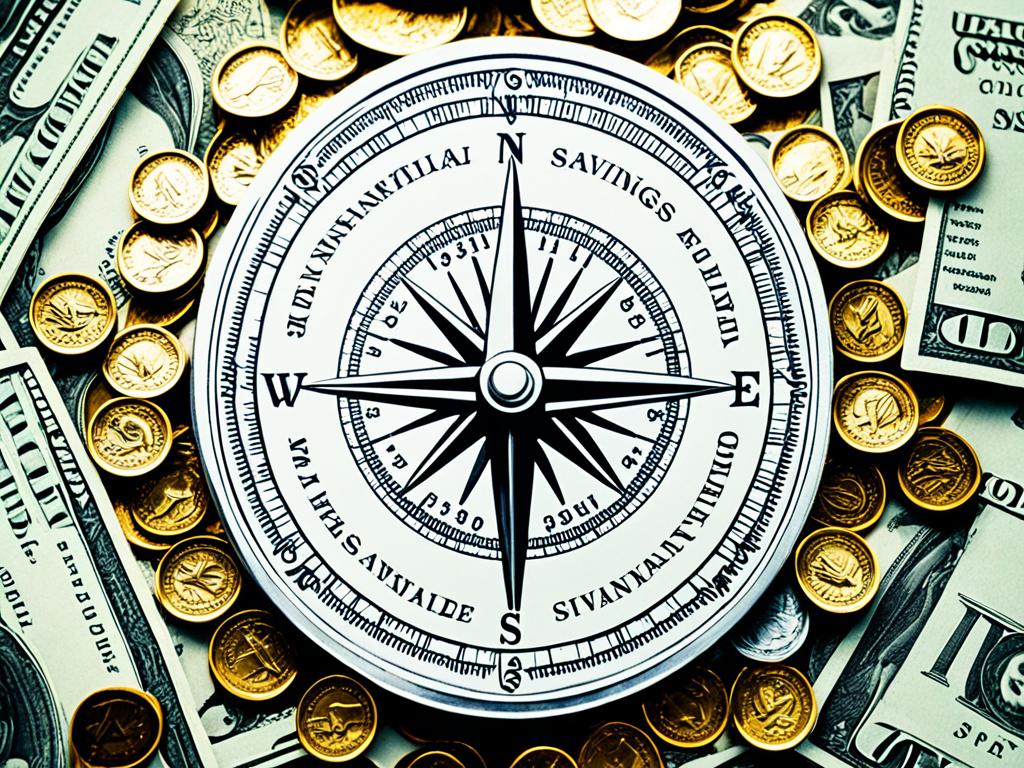
How to Create a Sustainable Savings Plan
Creating a strong savings plan is key to financial stability and reaching your goals. It’s important for saving for emergencies, a house down payment, or retirement. A good savings plan ensures you meet your financial goals and feel secure.
We’ll cover the main strategies and best practices for a lasting savings plan. You’ll learn how to assess your finances, set achievable goals, and use different savings accounts. This will help you craft a savings plan tailored to your needs.

If you’re starting your financial journey or want to improve your savings plan, this guide is for you. It offers the tools and knowledge to build a strong financial base. You’ll be able to reach your financial goals with confidence.
The Importance of Building a Savings Plan
A solid savings plan is key to financial stability and managing wealth over time. It helps you prepare for unexpected costs and move towards your goals. By focusing on saving for emergencies and setting financial targets, you can handle surprises and reach your dreams.
Savings Plan: Preparing for Emergencies
Life can throw curveballs like medical bills, losing a job, or fixing your home. Without savings, these can quickly drain your funds. An emergency fund is a safety net. It’s money set aside for these sudden costs, avoiding the need for high-interest loans or credit cards.
Achieving Financial Goals
A savings plan helps you reach your big financial goals, like saving for retirement, a house, or college. By putting money into retirement accounts and other savings, you build up your resources. This way, you can achieve your dreams and secure your financial future.
Creating a detailed savings plan is a smart move for your financial health. It helps you stay ahead and ensures success in managing your wealth.

Evaluating Your Current Financial Situation
Creating a savings plan begins with knowing where you stand financially. Look at your income, expenses, and debts closely. This helps you build a strong base for budgeting and reducing debt, leading to better financial planning.
Start by listing your income, like your job, side gigs, and regular payments. Then, sort your expenses into categories, such as rent, bills, food, transport, and debts. This will show you where you spend most and where you can save.
- List your income sources:
- Salary
- Side hustles or freelance work
- Other regular payments
Categorize your expenses:
- Rent or mortgage
- Utilities
- Groceries
- Transportation
- Outstanding loans or credit card payments
With a clear view of your finances, you can spot ways to spend less and save more. This step is key to a good budgeting, debt reduction, and financial planning strategy.

Assessing your finances well prepares you to make smart choices. It helps you move towards your financial goals.
Setting Realistic Savings Goals
Starting with achievable financial goals is key to a good savings plan. You might want to save for emergencies, a house down payment, or retirement. It’s important to set goals that are specific, measurable, and have a deadline.
Short-Term vs. Long-Term Goals
It’s vital to balance short-term and long-term financial goals. Short-term goals, like saving for a trip or a new gadget, give you quick rewards and motivation. Long-term goals, such as saving for retirement or college, need more effort but can greatly improve your financial future.
Prioritizing Your Goals
- Evaluate your current financial situation to see which goals are most important and realistic.
- Prioritize your goals by looking at their urgency, impact, and how they fit with your financial plan.
- Break down larger goals into smaller steps to keep yourself motivated and on course.
- Review and adjust your goals as your situation and priorities change.
By setting realistic financial goals, making a detailed savings plan, and checking your progress often, you can manage your finances better. This helps you build a strong base for long-term wealth management.

Savings Plan: Creating a Budget and Tracking Expenses
Creating a solid budgeting plan and keeping an eye on your expenses is key to getting financially stable and cutting debt. By watching your spending and finding ways to improve, you can make smart choices. These choices help you reach your financial planning goals.
Identifying Unnecessary Expenses
Start by looking at how you spend your money now. Go through your past bills and sort them into must-haves and nice-to-haves. This way, you can spot where you can cut back on spending. Then, you can move that money to your savings.
- Check subscriptions and memberships you don’t use or need anymore.
- Look at how much you spend eating out and on entertainment to find ways to save.
- Review your car costs, like payments, fuel, and insurance.
- Find ways to lower your utility bills, like using less energy.
By cutting these unnecessary expenses, you can save more for your budgeting and savings plan. This will boost your financial planning.

Savings Plan: Strategies and Accounts
Creating a solid savings plan is key to a secure financial future. Consider using automated savings and retirement accounts to boost your savings. These methods can help you save more and use compound interest to grow your money over time.
Automated Savings
Automating your savings is a smart way to grow your money. Set up automatic transfers from your checking to a savings account. This way, you’ll save money without having to think about it. It makes reaching your savings goals easier.
Retirement Accounts
Retirement accounts like 401(k)s and IRAs come with tax benefits that can increase your savings. By putting money into these accounts, you delay paying taxes on your earnings. This lets your money grow faster through compound interest. Plus, some employers match your contributions, doubling your savings.
Whether you’re saving for emergencies or retirement, a good savings plan with these strategies can help. It can help you meet your financial goals and ensure your financial security in the future.
Savings Plan: Investment Strategies for Long-Term Growth
For long-term financial growth, a strategic approach to investing is key. By using investment strategies, you can create a strong wealth management plan. This plan should match your financial goals and how much risk you can handle. The power of compound interest is a big help in growing your retirement accounts over time.
Diversifying your investments is crucial. A mix of stocks, bonds, and other assets can reduce risk and increase returns. Using retirement accounts like 401(k)s and IRAs can also give your savings a big boost.
Compound interest has a big impact on your savings. By investing and reinvesting your earnings, your savings can grow much faster over time. This is especially true for younger investors who have more years to benefit from compounding.
Long-term financial growth needs a balanced approach. It includes investment strategies, saving regularly, and understanding compound interest. Using these tools can help you build a strong foundation for a secure future.
- Diversify your portfolio to manage risk
- Maximize the benefits of compound interest in retirement accounts
- Develop a long-term wealth management strategy
Conclusion
In this article, we looked at how to make a lasting savings plan. This plan helps you reach your financial goals and secure your future. We covered the basics of building a savings plan, checking your finances, setting achievable goals, and using smart strategies.
Creating a strong savings plan is key to managing your money well. By using the tips from this article, you can be ready for emergencies, chase your dreams, and build a solid financial base. Success comes from being willing to act and make smart choices with your money.
Your financial future is up to you. With the right steps, you can find financial stability and growth. Start using the savings plan, financial planning, and wealth management ideas. Begin your path to a secure and prosperous future today.
FAQ
What is a sustainable savings plan, and why is it important?
A sustainable savings plan helps you set aside money for your goals. This could be for an emergency fund, retirement, or other big goals. It’s key for financial stability and handling unexpected costs or life changes.
How do I evaluate my current financial situation to create a savings plan?
Start by tracking your income and expenses. Look at fixed and variable costs, and any debts you have. This helps you see where you can save more money.
How do I set realistic savings goals?
Think about both short-term and long-term goals. Short-term might be saving for an emergency or a big buy. Long-term could be for retirement or a home down payment. Make a plan to reach these goals step by step.
What are some strategies for creating and sticking to a budget?
Good budgeting means cutting unnecessary costs and automating savings. Use tools or apps to track spending and stay on target with your savings.
How can I make the most of my savings through investment strategies?
Investing can grow your savings over time with compound interest. Spread your investments across different areas like stocks, bonds, and real estate. Retirement accounts like 401(k)s and IRAs offer tax benefits for long-term saving and investing.
What are the benefits of automating my savings?
Automating savings by setting up regular transfers helps you save without the urge to spend. This “pay yourself first” method ensures you always save for your goals.



Nice tips.
Thanks for the practical tips! I’ve been struggling to save consistently, so this post was really helpful